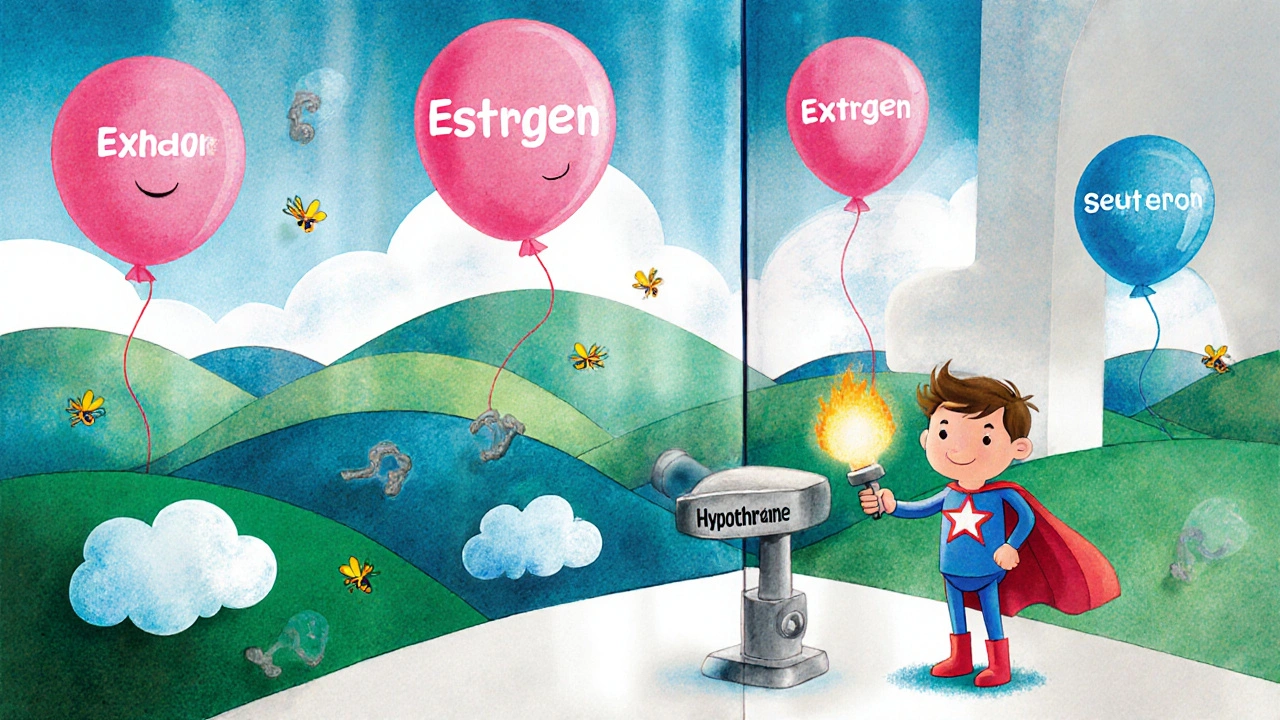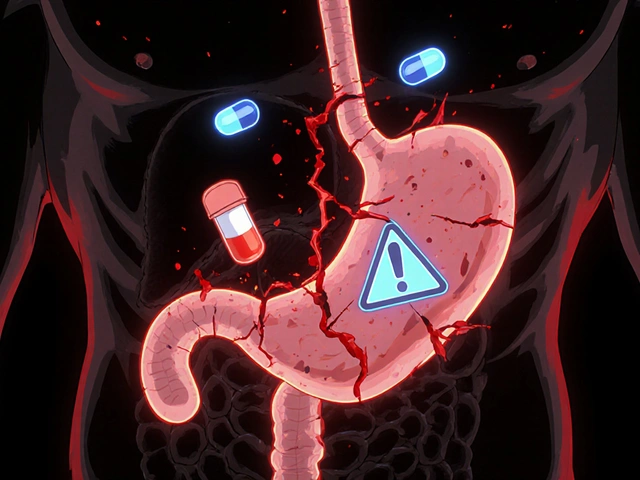Hormone Shift Comparison Tool
Understand the differences in hormonal shifts between natural postpartum recovery and cycles that include Clomiphene treatment.
Estrogen
Progesterone
Serotonin Activity
Cortisol
Important Note: This tool illustrates the hormonal differences discussed in the article, but individual experiences vary significantly. Always discuss your personal situation with a healthcare provider.
Many women wonder whether a drug they use to boost fertility could also affect their mood after giving birth. The question isn’t just academic-if a connection exists, it changes how doctors counsel patients during a vulnerable time.
What Clomiphene Actually Is
Clomiphene is a selective estrogen receptor modulator (SERM) prescribed to induce ovulation in women with anovulatory infertility. It works by binding to estrogen receptors in the hypothalamus, tricking the brain into thinking estrogen levels are low. This false signal prompts the pituitary gland to release more follicle‑stimulating hormone (FSH), which stimulates the ovaries to produce mature eggs.
How Clomiphene Alters Hormonal Balance
The drug’s primary effect is a surge in Estrogen a steroid hormone that regulates the menstrual cycle and influences mood. While the body eventually restores its own estrogen production, the temporary dip followed by a rebound can shift the delicate balance with other hormones such as Progesterone a hormone that prepares the uterine lining for pregnancy and has calming effects on the brain.. The interplay between estrogen and progesterone affects neurotransmitters like Serotonin a key mood regulator produced in the brain and gut., which is why some women report mood swings during clomiphene cycles.
Postpartum Depression: A Brief Overview
Postpartum depression a mood disorder that affects roughly 1 in 7 new mothers, characterized by persistent sadness, anxiety, and loss of interest. The condition typically emerges within four weeks of delivery but can appear up to a year later. Hormonal upheaval is a central driver: after birth, estrogen and progesterone plunge sharply, while cortisol and prolactin rise. These shifts interact with the brain’s serotonin system, sometimes triggering depressive symptoms.

Biological Pathways That Could Connect Clomiphene and Postpartum Mood
There are three plausible mechanisms linking the fertility drug to postpartum depression:
- Extended Estrogen Modulation: Women who continue clomiphene into early pregnancy may experience a prolonged period of altered estrogen receptor activity, which could delay the normal hormonal reset that follows delivery.
- Serotonin Interaction: By changing estrogen levels, clomiphene indirectly influences serotonin synthesis and reuptake. If serotonin pathways are already vulnerable-common during the postpartum period-the drug might tip the balance toward depressive symptoms.
- Stress Amplification: Fertility treatment itself is stressful. Adding the physical side‑effects of clomiphene (hot flashes, mood swings) can increase cortisol, a hormone that aggravates anxiety and depression.
What the Research Says (as of 2025)
Evidence is still emerging, but a handful of studies provide clues:
- A 2022 prospective cohort of 1,200 women undergoing ovulation induction found a 12% higher incidence of postpartum depressive symptoms in those who used clomiphene versus a control group receiving letrozole.
- A 2024 meta‑analysis of five small trials reported a modest increase in Edinburgh Postnatal Depression Scale (EPDS) scores (mean difference=1.3) among clomiphene users, though the effect size was deemed clinically borderline.
- Animal models published in 2023 showed that chronic exposure to SERMs altered hippocampal serotonin receptor density, a change linked to depressive‑like behavior.
Overall, the data suggest a possible association, but confounding factors-such as the psychological impact of infertility and the use of other hormonal agents-make it hard to draw a firm causal line.
Practical Guidance for Women on Clomiphene Who Are Expecting
If you are taking clomiphene and planning a pregnancy, consider these steps:
- Track Mood Changes: Keep a simple diary of emotions, sleep quality, and any anxiety spikes. Sharing this record with your obstetrician can reveal patterns early.
- Discuss Medication Timing: Some clinicians pause clomiphene once a viable pregnancy is confirmed, switching to natural hormone support or a less estrogen‑modulating agent.
- Screen for Depression: Ask your provider to administer the EPDS or another validated tool during prenatal visits.
- Consider Complementary Support: Light therapy, regular exercise, and counseling have all shown benefit for postpartum mood and can offset any hormonal stress.
- Know When to Seek Help: Persistent sadness, thoughts of self‑harm, or inability to care for your baby warrant immediate professional attention.

Key Hormonal Shifts: Clomiphene vs. Natural Postpartum Recovery
| Hormone | Natural Postpartum (first 6 weeks) | Clomiphene‑treated Cycle |
|---|---|---|
| Estrogen | Sharp decline, then gradual rise | Initial decline, followed by a rebound spike due to receptor blockade |
| Progesterone | Low to undetectable | Suppressed early, may rise later in cycle |
| Serotonin activity (indirect) | Fluctuates with estrogen drop | Potentially reduced reuptake inhibition, leading to lower synaptic levels |
| Cortisol | Elevated due to stress of new motherhood | May increase further from treatment‑related stress |
Understanding these differences helps clinicians decide whether to modify or discontinue clomiphene once pregnancy is established.
Bottom Line for Readers
While a direct cause‑and‑effect link between Clomiphene and postpartum depression has not been conclusively proven, the hormonal pathways overlap enough to merit attention. Alert monitoring, open conversation with your care team, and early mental‑health screening are the safest ways to navigate both fertility goals and postpartum well‑being.
Frequently Asked Questions
Can clomiphene cause depression during pregnancy?
Most research points to a modest increase in depressive symptoms, especially in the postpartum period. During pregnancy itself, the evidence is weaker, but monitoring is still advised.
Should I stop taking clomiphene once I’m pregnant?
Many providers discontinue clomiphene after a viable pregnancy is confirmed and switch to natural hormone support or a different ovulation agent. Discuss timing with your reproductive endocrinologist.
How is postpartum depression diagnosed?
Clinicians typically use the Edinburgh Postnatal Depression Scale (EPDS) or the Patient Health Questionnaire‑9 (PHQ‑9). Scores above the threshold trigger further evaluation.
Are there safer fertility drugs for women worried about mood?
Letrozole, an aromatase inhibitor, has a lower impact on estrogen receptors and is often preferred for women with a history of mood disorders. Still, any medication should be chosen in partnership with a specialist.
What lifestyle steps can reduce the risk of postpartum depression?
Regular physical activity, adequate sleep, balanced nutrition, and strong social support are proven protective factors. Early prenatal counseling also helps set realistic expectations.






The dance between hormones and mood is a reminder that our bodies are ecosystems of signals.
When clomiphene nudges estrogen receptors, it sparks a cascade that reverberates through the brain's serotonin highways.
This biochemical ripple can feel like a subtle breeze or a sudden storm, depending on the individual's neurochemical landscape.
Imagine a tightrope walker balancing on a fragile line; the added weight of fertility treatment can shift the center of gravity.
For many new mothers, that shift coincides with the postpartum plunge of estrogen and progesterone, a double‑dip that challenges equilibrium.
Research from 2022 to 2024 hints at a modest uptick in depressive scores among clomiphene users, a pattern worth noting.
Yet numbers alone do not capture the lived experience of a mother navigating sleepless nights and hormonal flux.
Proactive mood tracking becomes a compass, guiding clinicians toward timely interventions.
Light therapy, gentle exercise, and supportive counseling can act as anchors in the swirling sea of postpartum emotions.
🌟 Embracing these tools empowers women to rewrite the narrative from vulnerability to resilience.
Moreover, discussing medication timing with a reproductive endocrinologist can tailor the hormonal journey to each unique case.
Some providers pause clomiphene once a viable pregnancy is confirmed, opting for natural hormone support-a strategy that aligns with the body's natural reset.
In the grander philosophical view, we are reminded that medicine is a partnership, not a prescription of fate.
Each decision echoes beyond the uterus, touching the brain's delicate serotonin orchestra.
By listening closely to mood cues, we honor the interconnectedness of body and mind.
So, while the link may not be ironclad, staying vigilant offers the best safeguard for both fertility goals and postpartum well‑being.